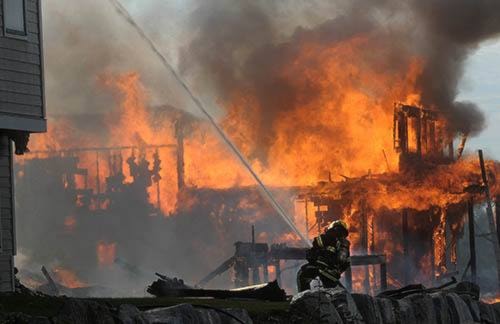Maple Ridge could be sued by angry residents for not having a wildfire protection area in place, if a forest fire wipes out homes.
“I think we’re exposing the municipality to liability and risk,” former fire chief Peter Grootendorst told council Monday.
With 60 per cent of the district exposed to forest, “it’s a huge risk here in Maple Ridge.”
Mayor Ernie Daykin agreed.
“We’re abstaining from our responsibility if we don’t move this forward.”
The permit areas are the final step after the approval of the Wildfire Protection Plan in 2007.
Council decided more than a year ago against adopting the wildfire development permit area guidelines because of higher costs to developers. The guidelines would apply outside Maple Ridge’s built-up areas would require 10-metre buffers between homes and the forest and fire-resistant walls and roofs for homes that face the forest.
Silver Valley would be included in the permit area.
On Monday, council approved writing a bylaw to incorporate the guidelines, after they were reviewed and endorsed by consultant Mark Brown.
Couns. Al Hogarth and Corisa Bell voted against the bylaw.
“I think we have to keep moving the ball forward,” said chief administrator Jim Rule.
Bell wanted an implementation plan prepared before the bylaw was introduced. Council passed a similar resolution in 2007.
“I just don’t understand, if it’s a safety concern, why it’s taken 10 years to get to this point,” she said.
Coun. Hogarth added: “I really disagree with the ‘let’s do this first and then we’ll worry about the rest later.’ I think the public needs to know what the cost is.”
The guidelines would apply to only new suburbs or if homes underwent major renovations.
Grootendorst said the cost isn’t as “big and scary as it initially appeared to be.”
Provincial grants can pay for 90 per cent of clearing of forests. He noted that after three meetings with developers in 2012, most were comfortable that the new rules wouldn’t affect the number of lots that could be built on a piece of land, although the layout would have to change.
Builders were given as much flexibility as possible in meeting standards, such as using drywall beneath vinyl exterior walls in place of the fire-resistant cement-based exterior siding.
He previously said that building a home to fit the new requirements would add another $5,000 to the price.
It’s not only homes that face the forest that are at risk. Any house within a 20-hectare area could be subject to an “ember shower,” in which burning embers fall down on homes below like snow, potentially igniting any surface they fall upon.
Council wanted to know how much Maple Ridge was at risk of forest fires.
“We’ve had several close calls,” said Grootendorst.
Brown, who used to work in North Vancouver, which already has a wildfire plan, said what struck him the most about Maple Ridge was the degree to which the community was woven into the forest.
“It’s also a very difficult thing to manage in terms of the wildfire risk that the community is exposed to.”
But the financial risks of a wildfire are high given the cost of housing. Infrastructure is also at risk.
“It’s almost a 50-50 chance of a structure fire causing a forest fire these days,” said Brown.
He noted that crucial communications towers on Thornhill could become useless during an emergency if a fire burns wooden power poles that connect them. A better way is to bury the lines or use steel or concrete poles.
He also proposed that more land, around Webster’s Corners and Whonnock Lake, be added to the permit areas.
“The way the community has historically developed in the surrounding forest has created a significant legacy of homes which would be extremely difficult to protect,” Brown said in his review.
The presentation included several photos that showed homes tucked into forests, narrow driveways and no defensible space that would give them a chance of surviving a fire.
In the case of a widespread fire, crews would be hopeless to stop it, leaving it up the each home, hopefully with fire protection measures in place, to take its chances.
“There’s no amount of manpower we can throw at this,” Brown said.
Council will look at the bylaw at its May 26 meeting, along with a staff report that will try to answer council questions.
